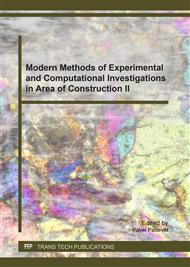p.22
p.28
p.34
p.40
p.48
p.54
p.59
p.65
p.70
Dependence of Tensile Bending Strength of Rammed Earth on Used Clay Composition and Amount of Mixture Water
Abstract:
Clay is a traditional construction material which has got to background with introduction of modern materials to building practice. There is not proper material available for clay constructions design due to a lack of proper examination of its mechanical properties. This article focuses on tensile bending strength of rammed earth. The mechanical properties depend on the amount of mixture water and on the amount and type of clay minerals. The clay minerals play role of the binder similarly like a cement in concrete. This paper is focused on the tensile bending strength and its dependence on the composition and quantity of clay mineral and its dependence on the amount of mixture water. Five earth mixtures were tested. Mechanical properties were examined on small test bodies made of these mixtures. The mechanical properties of the five mixtures are compared at the end of the paper.
Info:
Periodical:
Pages:
48-53
Citation:
Online since:
March 2017
Authors:
Price:
Сopyright:
© 2017 Trans Tech Publications Ltd. All Rights Reserved
Share:
Citation:


